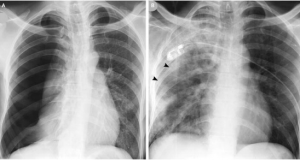This case was brought to my attention by the wonderful Sam Schuberg. Impressively he drained a large pleural effusion in the ED offering his patient “Upstairs Care Downstairs”.
He then brought to my attention that when draining a large amount of fluid be weary of…
REEXPANSION PULMONARY EDEMA or RPE!
 [picture from Tariq & Sharif 2006]
[picture from Tariq & Sharif 2006]
What’s that you say? It is pulmonary edema that occurs after removal of fluid or air from the lung.
First described by Francis Pinault in 1853
RPE is fairly rare approx <1%
But the mortality can be as high as 20%!! (but even that’s up for debate…)
Pathophysiology: Who Knows?!
- It may result from a precipitous drop in intrapleural pressure
- This led some to recommend measuring manometry during a thoracentesis and if below -20cm then stop the procedure
- However Feller-Kopman et al (2007) found the opposite that patients w/ RPE had higher intrapleural pressures
- It may result from inflammation! Such as cytokine release and increased capillary permeability (Kasmani et al 2010)
- Farkas speculates that high opening pressures and therefore large initial pleural effusions or pneumothoraces may increase the incidence of RPE
For more ask Farkas
How much can we drain? (Again no clear defined cutoff…)
- Some such as Daniels & Ryu (2011) recommend 1-1.5L
- Feller-Kopman et al (2007) found RPE occurrence after an average of 2.4L removal
- Dias et al 2010 found that 1.8L of fluid could safely be removed
What’s the management?
- When draining a thoracentesis consider stopping if the patient experiences “vague” chest pain (Feller-Kopman et al 2006)
- Place patient in a lateral decubitus position with the “Good” lung down and the RPE or “Bad” lung up
- Provide supplemental O2 such as NC, NIV-BIPAP, or Invasive Mechanical Ventilation if needed
Sources:
- Farkas, J. 2014. Large volume thoracentesis: How much can safely be removed. accessed <http://emcrit.org/pulmcrit/large-volume-thoracentesis-how-much-can-safely-be-removed/>
- Daniels, C. E., & Ryu, J. H. (2011). Improving the safety of thoracentesis.Current opinion in pulmonary medicine, 17(4), 232-236.
- Dias, O. M., Teixeira, L. R., & Vargas, F. S. (2010). Reexpansion pulmonary edema after therapeutic thoracentesis. Clinics, 65(12), 1387–1389. http://doi.org/10.1590/S1807-59322010001200026
- Feller-Kopman, D., Berkowitz, D., Boiselle, P., & Ernst, A. (2007). Large-volume thoracentesis and the risk of reexpansion pulmonary edema. The Annals of Thoracic Surgery, 84(5), 1656-1661.
- Feller-Kopman, D., Walkey, A., Berkowitz, D., & Ernst, A. (2006). The relationship of pleural pressure to symptom development during therapeutic thoracentesis. CHEST Journal, 129(6), 1556-1560.
- Kasmani, R., Irani, F., Okoli, K., & Mahajan, V. (2010). Re-expansion pulmonary edema following thoracentesis. CMAJ : Canadian Medical Association Journal,182(18), 2000–2002. http://doi.org/10.1503/cmaj.090672
- Tariq, S. M., & Sadaf, T. (2006). Reexpansion pulmonary edema after treatment of pneumothorax. New England Journal of Medicine, 354(19), 2046-2046.
